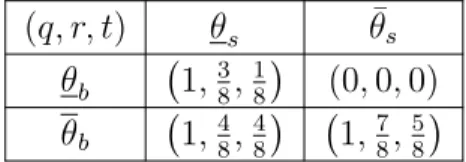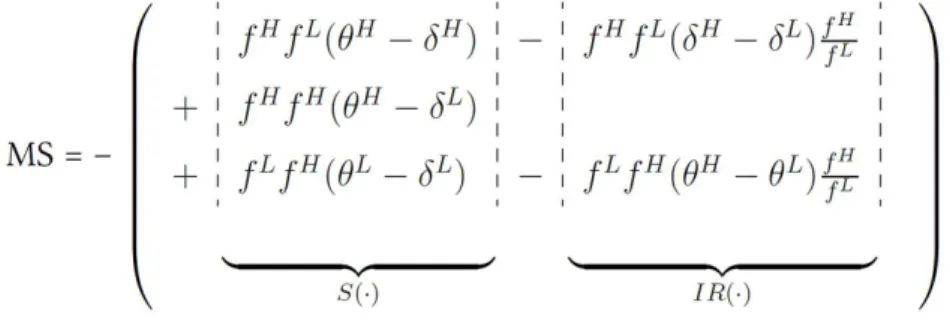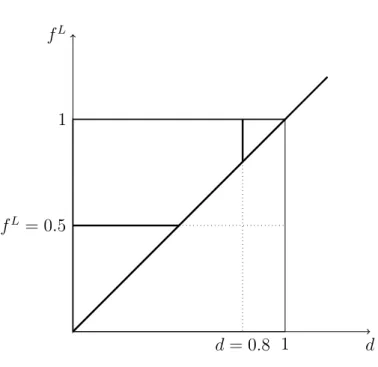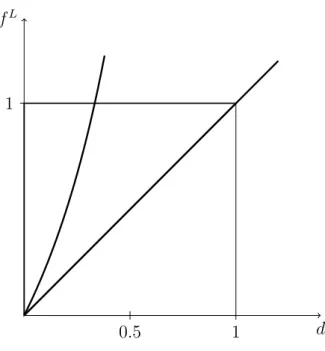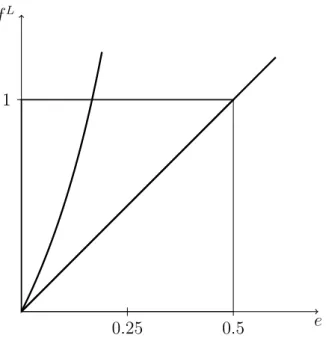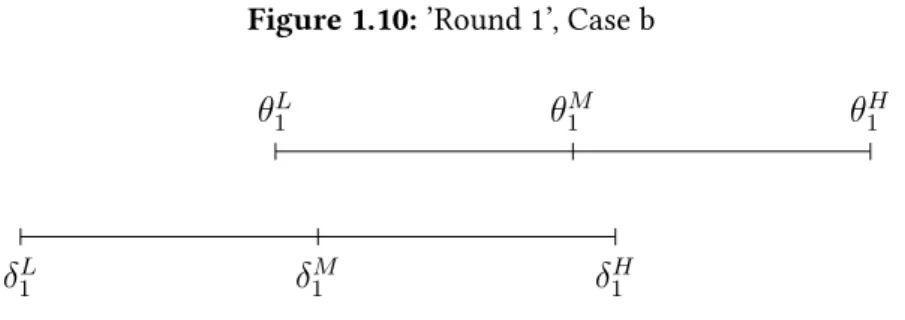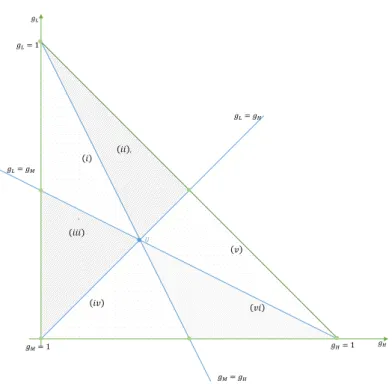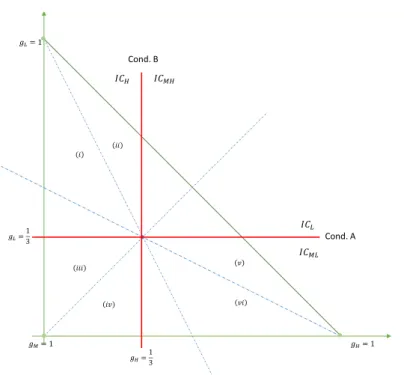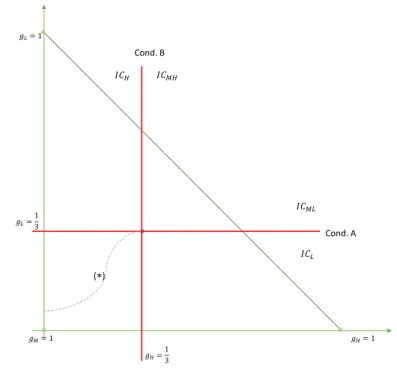Inauguraldissertation zur
Erlangung des Doktorgrades der
Wirtschafts- und Sozialwissenschaftlichen Fakultät der
Universität zu Köln 2018
vorgelegt von
Diplom-Mathematikerin Laura Kohlleppel aus
Bochum - Wattenscheid
Korreferent: Prof. Dr. Martin Barbie
Tag der Promotion: 07.09.2018
First of all, I am very grateful to Felix Bierbrauer, my first supervisor, for advising me during my dissertation and teaching me how to ask the relevant questions. His enthusi- asm towards economic research has been a constant source of learning and inspiration.
The first chapter is joint work with him.
Particular thanks must also be given to Martin Barbie, my second supervisor, for dili- gently reading my papers and giving valuable feedback and further to John Weymark for having me twice at Vanderbilt University providing an environment that allowed me to make great progress on this thesis.
Representative for all the fellow students who supported me while working on this thesis, I would like to express my deepest gratitude towards my co-authors Désirée Rück- ert and Frederik Thenée. It was by far the most joyful experience during my dissertation to work together on our common projects. I am very grateful to them for not getting tired of discussing, explaining, commenting and motivating. I have learned so much and feel honored to call them not only co-authors but also friends. The first and the third chapter, respectively, are joint work.
Finally and, most importantly, I owe big thanks to my family. To my parents who believe in me even when I do not – for their unconditional support. To my sisters who are the most loyal companions in life – for always fighting on my side whichever it is.
To Clemens who has been by my side, day by day, and went all the way with me – for holding me and never loosening the grip.
Laura Kohlleppel
Introduction 1 1 On the independent private values model – A unified approach 5
1.1 Introduction . . . . 5
1.2 Related literature . . . . 8
1.3 Motivating examples . . . 10
1.3.1 The bilateral trade problem . . . 10
1.3.2 Public good provision . . . 13
1.3.3 Comparison of private and public good. . . 14
1.4 The model . . . 15
1.5 Implementable provision rules . . . 19
1.5.1 Necessary condition . . . 19
1.5.2 Sufficient condition . . . 21
1.5.3 Efficiency . . . 22
1.6 Comparative statics I: From few to many agents . . . 24
1.6.1 Possibility results when the type set is binary . . . 24
1.6.2 Many agents . . . 30
1.7 Comparative Statics II: From few to many types . . . 32
1.7.1 Introducing a third type. . . 32
1.7.2 Introducing many types . . . 36
1.7.3 General convergence . . . 39
1.7.4 Convergence of type set . . . 42
1.8 Concluding remarks . . . 44
Appendix 1.A Preliminaries . . . 45
Appendix 1.B Proofs of Propositions and Corollaries . . . 55
Appendix 1.C Applications . . . 67
Appendix 1.D From discrete to continuous for the firm side . . . 73
Appendix 1.E Proof of Observations . . . 74
2 Optimal non-linear income taxation for arbitrary welfare weights 79 2.1 Introduction . . . 79
2.2 Environment . . . 84
2.3 Simplex of welfare weights . . . 86
2.4 Welfare maxima and optimal marginal taxes . . . 91
2.4.1 The reduced-form problem . . . 91
2.4.2 Optimal marginal taxes and bunching . . . 94
2.5 Further steps to go and conclusion . . . 101
2.5.1 Notes on the second-best Pareto frontier . . . 101
2.5.2 Conclusion . . . 103
Appendix 2.A Proof of Corollaries . . . 105
Appendix 2.B Proof of Propositions . . . 109
Appendix 2.C Proof of Lemmata . . . 120
3 Public Goods and Salience 123 3.1 Introduction . . . 123
3.2 Model description . . . 128
3.2.1 Theoretical framework . . . 128
3.2.2 Equilibrium analysis and comparative statics . . . 130
3.3 Welfare . . . 135
3.3.1 Unweighted Utilitarian welfare and comparative statics . . . 136
3.3.2 Optimal government behavior and crowding-in . . . 141
3.4 Conclusion . . . 145
Appendix 3.A Proof of Propositions . . . 146
Appendix 3.B Proof of Lemmata . . . 150
Appendix 3.C Proof of Corollaries . . . 152
Bibliography 153
1.1 Binary type set . . . 12
1.2 Minimal subsidy for a binary type set . . . 26
1.3 Changing parameters in the bilateral trade setting . . . 26
1.4 Possibility of efficient trade . . . 28
1.5 Three buyer and seller types . . . 33
1.6 Bilateral trade – Comparison between ’round 0’ and ’round 1’ . . . 35
1.7 Violating the ’Uniform Extension’ procedure . . . 36
1.8 Three consumer types . . . 37
1.9 Public good – Comparison between ’round 0’ and ’round 1’ . . . 38
1.10 ’Round 1’, Case b . . . 77
2.1 Simplex of welfare weights . . . 88
2.2 Simplex of welfare weights with partitioning . . . 90
2.3 Simplex of welfare weights with separating line (?) . . . 119
1.1 Positive minimal subsidy . . . 12
1.2 Negative minimal subsidy . . . 13
The given thesis includes three independent chapters which all contribute to the the- ory of public economics. They are linked, theoretically, by the fact that an information asymmetry is included in the presented environment. In the first two chapters agents are assumed to hold private information on their preferences. Making use of a mechanism design approach, applications such as a bilateral trade problem, the provision of a pub- lic good and the design of an optimal income tax schedule are studied. More precisely, Chapter 1 relates discrete and continuous formulations of the independent private val- ues model and derives conditions under which these two behave qualitatively the same.
Chapter 2 studies how a Mirrleesian income tax model is affected by the assumption of arbitrary directions of redistribution and addresses the question how the corresponding optimal income tax schedules should be designed. In the third chapter individuals are incompletely informed about the characteristics of a public good. Only incomplete in- formation on the good’s productivity and governmental contributions are available such that salience becomes a driving factor for individual behavior and hence, the provision of the good.
A common aim of all three chapters is to disentangle and evaluate the effects of infor- mation asymmetry in the respective setting. In an environment as considered in the first two chapters, individuals being privately informed about preferences yields a social cost.
Thus, only a second-best situation can be reached where welfare is lower compared to a full information environment. However, this is not true in a situation as studied in Chap- ter 3. Here, the information asymmetry can be exploited by a benevolent government to improve welfare compared to a situation with complete information. Conclusively, the effects of information asymmetry on welfare and optimal allocations are non-trivial and depend on the considered environment.
Chapter 1 The first chapter is based on joint work with Felix Bierbrauer and Désirée Rückert. It studies two representative applications – the bilateral trade problem and the provision of a public good – in different formulations of the independent private values model. In this workhorse model of mechanism design, agents are privately in- formed about their preferences. In our setup, consumers are privately informed about the marginal benefit of consumption, while producers are privately informed about the marginal cost of production. Typically, in the independent private values model, those
"types" are drawn from a continuum with a corresponding atomless distribution. We contrast this continuous formulation with a discrete specification and compare the im- plementability of efficient outcomes.
At first, necessary and sufficient conditions for the implementability of a social choice
function are derived for the discrete specification of the model. Secondly, we study how
the implementability of a social choice function varies in the parameters of the model, e.g. the number of types or the number of individuals. For this purpose, we define a measure which quantifies how costly it is to implement efficient outcomes.
Regarding the two applications, contrary observations are made with respect to the question whether the implementability of efficient outcome is the same in both the con- tinuous and the discrete formulation. While the impossibility result of Mailath and Postlewaite (1990) on the provision of public goods preserves in any model with discrete types, this is not true for a private good setting. The impossibility result by Myerson and Satterthwaite (1983) for the bilateral trade problem with a continuum of types does not extend to a setting with discrete types. We deliver parameter constellations that allow to efficiently trade a private good. The final section in this chapter provides conditions under which discrete and continuous formulations of the independent private values model behave approximately the same.
Chapter 2 In the second chapter, a discrete version of the Mirrleesian income tax model is used to study welfare maximizing tax schedules under the assumption of ar- bitrary redistributive preferences of the planner. An economy with three productivity types is studied and the welfare function is a weighted Utilitarian. Redistributive pref- erences are reflected by the welfare weights assigned to the three productivity types, respectively. The model does not put any assumptions on these welfare weights and, hence, covers every possible redistributive preference that can be expressed by a Utili- tarian welfare function. Typically, models building on Mirrlees (1971) consider welfare weights that decrease in productivity. This yields optimal redistribution towards the poor, formally given by downward binding incentive constraints.
For weights that are non-monotonic, the set of binding incentive constraints is a priori unknown and has to be identified. A perturbation argument is used to assign binding incentive constraints to given welfare weights. The results are aggregated in two formal conditions which partition the set of welfare weights into four subsets (and its bound- aries) according to the pattern of binding incentive constraints.
Having identified the binding constraints for each subset, allows to state a reduced form of the original welfare maximization problem. Optimal allocations are derived by a first order approach. The corresponding optimal marginal tax rates are such that it is never optimal to overly encourage low-skilled individuals to work or to discourage high- skilled individuals from work which is equivalent to non-negative marginal tax rates for low-skilled and non-positive tax rates for high-skilled. The median type’s optimal tax rate can have either sign depending on the direction of redistribution. Furthermore, depending on the specific form of preferences bunching can occur. Though, given that preferences fulfill the single-crossing condition, some types of bunching can be ruled out for further specified welfare weights.
The chapter concludes by discussing the relation of welfare maximizing and second-
best Pareto efficient allocations.
Chapter 3 The third chapter is based on joint work with Frederik Thenée. It investi- gates how the provision of a public good is affected by salience. Two types of salience are studied: firstly, individuals are assumed to be incompletely informed about the qual- ity of the public good and, hence, responsive to salience. More precisely, individuals are assumed to underestimate the marginal benefit of a contribution to the public good.
Secondly, the salience of taxes has an impact on the individuals’ behavior as they are assumed to misperceive governmental contributions to the public good. The analysis focuses on incompletely salient taxes where individuals underestimate the amount of public contributions. In a model similar to Bergstrom et al. (1986) or Andreoni (1990) the interplay of public and private contributions to charity is analyzed, in particular with regard to salience as a driving force of behavior.
Chapter 3 can be subdivided in two main parts. The first is dedicated to the investi- gation of individual equilibrium behavior as a function of various factors such as public contributions, salience – in both of it dimensions – and the quality of the public good.
The second part evaluates these results and delivers a normative approach to public good scenarios where not only the provision level of the public good but also the induced wel- fare is considered.
As real world observations would suggest, private equilibrium contributions increase in the perceived quality of the public good and decrease with the level of perceived pub- lic contributions. Furthermore, as public contributions are only an imperfect substitute for private contributions, the aggregate provision level increases in public contributions.
This increase in the provision level alleviates the underprovision of the public good re- sulting from free-riding.
However, an increase in the aggregate provision is not equivalent to an increase in
welfare. Opposed to voluntary contributions, taxes do not create a warm glow. So,
crowding out private ones, public contributions come at the cost of a destroyed warm
glow. To evaluate the overall effect on welfare, the negative effect of a destroyed glow
has to be contrasted with the positive effects of reduced free-riding and increased aggre-
gate contributions. It can be shown that the positive effect never outweighs the negative
when taxes are perfectly salient. Only by their non-salience public contributions to a
public good are potentially beneficial. To identify conditions when this is actually the
case, crowding-in as defined by the concomitant increase of public and private contri-
butions is introduced as an indicator. Under the assumption of a welfare maximizing
government, it can be shown that it depends on the trigger of crowding-in whether the
increase in taxes raises welfare or not: if an increase in the good’s salience is the rea-
son for higher equilibrium contributions, increased taxes are never optimal. Contrary,
if crowding-in is caused by an increase in the good’s quality, higher taxes are poten-
tially welfare increasing. Raising taxes is actually beneficial if the problem of free-riding
became more severe by the quality shock.
For exposition, we study the public good "charity".
On the independent private values model 1
– A unified approach
1.1 Introduction
The independent private values model is an important workhorse model for the the- ory of mechanism design. In this model, economic agents are privately informed about their characteristics, typically preferences or costs, and, moreover, the characteristics of different agents are modeled as the realizations of independent random variables. In addition, an individual’s payoff does not depend on the types of other individuals. This framework has been applied to study a wide range of allocation problems. These include the allocation of indivisible private goods (auctions), the provision of pure or excludable public goods, the regulation of externalities, the problem of partnership dissolution, or redistributive income taxation.
The seminal papers in this literature are based on the assumption that, for each agent, there is a continuum of possible types and that the corresponding probability distribution has no mass points and a monotone hazard rate. Moreover, the typical approach is to use the envelope theorem for a characterization of incentive compatible social choice functions. In this paper, we develop an alternative characterization of implementable social choice functions based on the assumption that the set of possible types is discrete.
More specifically, our analysis proceeds as follows.
We first provide necessary and sufficient conditions for the implementability of a so-
cial choice function. For our characterization, we introduce the notion of a minimal
subsidy. It is defined as the difference between the maximal payment that one can ex-
tract from individuals in the presence of incentive and participation constraints, and the
payment that would be required in order to ensure budget balance. That is to say, the
minimal subsidy is the amount of money an external party would have to provide so as
to make a given social choice function compatible with the requirements of incentive
compatibility, voluntary participation, and budget balance. However, we do not assume
that such an external party is actually available. Consequently, a social choice function
can be implemented if and only if the minimal subsidy is negative. We then apply our
characterization to clarify conditions under which the famous impossibility results by
Myerson and Satterthwaite (1983) and Mailath and Postlewaite (1990) extend to a model with a discrete set of types. Second, we provide a comparative statics analysis of how a change in exogenous parameters – such as the number of individuals, or the number of possible types per individual – affect the minimal subsidy. This allows us, for instance, to check whether a change in the economic environment makes it more or less difficult to implement an efficient provision rule for public goods. A final contribution of our pa- per is to spell out the conditions under which a model with a large but discrete number of types behaves approximately in the same way as a model with a continuum of types.
These results are derived in a model in which many consumers, who have private in- formation about their preferences, benefit from the provision of a private or public good.
Their payoffs are quasi-linear in the transfers they need to pay for the good. Further, many firms, which have private information about their costs, profit from the produc- tion of goods. Firm profits are quasi-linear in the revenues they receive for producing the good. Consumers’ consumption is bounded by the total output that is made available by the firms. To derive the minimal subsidy, we proceed as follows: The social choice function can be divided into a transfer and consumption rule for consumers and a rev- enue and production rule for firms. First, we hold the consumption rule for consumers fixed and derive the maximal transfers that consumers are able to make if incentive com- patibility constraints and participation constraints need to be respected simultaneously.
Similarly, we hold the production rule fixed for firms and derive the minimal revenue that firms are willing to accept if again incentive compatibility constraints and participa- tion constraints need to be respected. The differences between the maximal consumer transfers and the minimal firm revenues is the minimal subsidy. If the minimal sub- sidy is positive, i.e., the mechanism runs a deficit, then the specified consumption and production rules are not implementable. Contrary, if the minimal subsidy is negative, the implementation of the social choice function is possible. For the characterization of maximal consumer transfers and minimal firm revenues we use techniques developed in the non-linear pricing literature (e.g. Mussa and Rosen (1978)).
Our analysis proceeds as follows: We first derive necessary and sufficient conditions
for the implementation of a social choice function. For the characterization of the first
condition, we consider the problem of maximizing consumers’ transfers and the prob-
lem of minimizing firms’ revenues, taking only a subset of incentive compatibility and
participation constraints into consideration. Specifically, we consider the participation
constraints of the consumer with the lowest valuation for consumption and the incen-
tive constraints that prevent consumers to communicate lower preferences. Similarly,
we take into consideration the participation constraint of the firm with the highest costs
of production and the incentive constraints that prevent firms from exaggerating their
costs. The expression that arises from this relaxed problem, where only a subset of con-
straints is considered, provides a lower bound on the minimal subsidy. Thus, a necessary
condition for the implementation is that the minimal subsidy of this relaxed problem is
negative. Second, we derive a sufficient condition, which assures that the lower bound of the minimal subsidy can be reached. This condition is stated for monotone consumption and allocation rules so that the consumption rule and the production rule are monotone, so that consumers with higher willingness to pay for the good consume more than con- sumers with a lower willingness to pay; and similarly, firms with lower costs produce more output than firms with higher costs.
These conditions have the following implications: first-best consumption and provi- sion rules are monotone. Therefore, first-best implementation is possible if and only if the minimal subsidy is negative. When the first-best provision rule is not implementable, monotonicity of the consumption and provision rules can be achieved when the distribu- tion of agents’ types satisfies a monotone hazard rate assumption. Hence, consumption and production plans that maximize a social surplus function subject to the constraint that the minimal subsidy is negative, are monotone and therefore implementable. To derive the necessary condition, the monotonicity of hazard rates does not play a role.
We present a version of the impossibility results of Mailath and Postlewaite (1990), when consumers have a discrete number of types. Our specification uses only the necessary condition to derive this result. We do not require the assumption of a monotone hazard rate that was imposed by Mailath and Postlewaite (1990) in order to attain the impossi- bility result. Hence, our result holds under less restrictive assumptions.
We provide comparative static results that show how the minimal subsidy varies with the number of types and the number of agents. In particular, we can compare the com- parative static properties of the minimal subsidy in a private good setting with a public good setting. A change in the number of agents affects the minimal subsidy in both set- tings differently. In a public good setting, an increase in the number of consumers leads to a positive minimal subsidy, so that it is impossible to efficiently provide the public good. Contrary, when a private good setting is considered, an increase in the number of buyers and sellers leads to a negative minimal subsidy. An increase in the number of types, on the other hand, increases the minimal subsidy, so that in the private good setting, as well as the public good setting, impossibility results occur when the number of types grows large.
In order to understand how parameter changes affect the minimal subsidy, we decom-
pose the effect of a change in parameters in the surplus measure and the measure for
information rents separately. We show that when each agent has a binary type set, then
parameters can be found such that efficient bilateral trade is possible. Further, if only
two consumers are considered, parameters can be found such that the public good can
be provided efficiently. We show that the ability to reach possibility results hinges on the
observation that parameters need to be chosen in such a way that the surplus measure
is bigger than the information rents that need to be guaranteed. This raises the question
how (i) the agent’s type parameters, (ii) the probability weights on types (iii) the number
of types and (iv) the number of agents influence the minimal subsidy. In particular, we
show that the possibility results that are derived with a binary type set ’approach’ the impossibility results of Myerson and Satterthwaite (1983) and Mailath and Postlewaite (1990) if the number of types increases and if the new types are introduced in such a way that the finite type set lies dense in the infinite type set, i.e., every point of the infinite type set can be approximated by a point of the finite subset of types. We demonstrate that the minimal subsidy in the discrete setting converges to the minimal subsidy in the continuous setting if the environments are aligned.
Based on these observations, we study general convergence results. We specify what we mean by one environment approaching another environment, so that results in a continuous setting and a discrete setting coincide. Therefore, we define an environment that allows us to compare and relate different economies, e.g. the discrete and the con- tinuous bilateral trade economy. Each of the economies is characterized by four decisive factors for implementability: the number of agents, the number of types, the probabil- ity distribution and the parameter constellation. Formally, we can approximate ’similar’
economies by adjusting the single components; i.e., as we increase the number of types and adjust the probability distribution, we transfer the discrete bilateral trade setting into the setting of Myerson and Satterthwaite (1983). If the components are adjusted
’appropriately’, we say that one economy will converge to the other economy. To re- late and analyze implementability results of different settings, we calculate the minimal subsidy and study what drives the possibility to attain efficient implementation in each economy. We give general insights on how different applications of the independent private values can be linked.
The reminder is organized as follows. The next section contains a more detailed dis- cussion of the literature. Section 1.3 provides counterparts to Myerson and Satterth- waite (1983) and Mailath and Postlewaite (1990) impossibility results. Section 1.4 intro- duces the model. To motivate our more general analysis in subsequent sections, Section 1.5 presents necessary and sufficient conditions for the implementation of social choice functions and characterizes first-best and second-best provision rules. Section 1.6 dis- cusses comparative statics properties of the bilateral trade problem and the public good provision problem. Further, this section studies the impact of increasing the number of agents on the possibility result. Section 1.7 then shows how the discrete type setting converges to the continuous type setting and analyzes the convergence in our examples.
The last section contains concluding remarks. Preliminary proofs are in Part 1.A of the Appendix. Part 1.C introduces further applications.
1.2 Related literature
The independent private values model has been applied to study a wide variety of alloca-
tion problems, from the allocation of indivisible private goods (auctions), to the bilateral
trade problem, the provision of pure or excludable public goods, the regulation of exter-
nalities, the regulation of a monopolist, or the problem of partnership dissolution.
In auction theory, the independent private values model is central. The seminal pa- per that introduced the second-price auction and the revenue equivalence theorem is Vickrey (1961). Optimal auctions for risk neutral bidders with independent types are derived in Myerson (1981), Riley and W. (1981), Harris and Raviv (1981) (see McAfee and McMillan (1987), for further references). Che and Gale (2006) show that the revenue equivalence theorem does not need to apply when the number of buyer types is finite.
Further, for the example of bilateral trade, Myerson and Satterthwaite (1983) have shown that if the buyer’s preferences and the seller’s costs are private information and voluntary participation needs to be assured, efficient trade is not possible. They intro- duce the notion of the minimal subsidy and thereby provide a measure of how severe the impossibility result is. We will show that this impossibility result does translate into a model with many finite types. For few finite types, however, parameters can be found such that efficient bilateral trade is possible; i.e., the minimal subsidy is negative. A special case of our setup is the paper of Matsuo (1989), who provides conditions under which efficiency in the bilateral trade example can be reached for discrete distributions with two types.
The possibility to achieve efficient public good provision as a Bayes-Nash equilibrium in an independent private values model has first been established by D’Aspremont and Gerard-Varet (1979) and Arrow (1979). This literature has not taken voluntary partici- pation into account. Güth and Hellwig (1986), Rob (1989) and Mailath and Postlewaite (1990) have shown that if preferences for public goods are private information, so that incentive compatibility constraints need to be considered and if at the same time volun- tary participation need to be guaranteed, then first-best efficient public good provision cannot be achieved. We will show that this impossibility result does not rely on the as- sumption that preferences for public goods are continuously distributed by showing that the impossibility extends to a setup with an arbitrary discrete type set. The provision of a non-rival, but excludable good is studied in Güth and Hellwig (1986), Hellwig (2003), Schmitz (1997) and Norman (2004).
The independent private values model has also been applied to study the dissolution
of partnerships, see Cramton et al. (1987). They look at situations where each of several
agents possesses a fraction of a good and assume a continuous symmetric distribution
of agents’ valuations. They show that an efficient reassignment of shares is possible if
initial shares are sufficiently equal distributed. However, when a single agent possesses
all shares of the partnership, then the same arguments as in Myerson and Satterthwaite
(1983) apply and an efficient dissolution is impossible. Hence, whether the partnership
can be dissolved efficiently relies on the initial shares of the partnership. As a corollary
of our analysis of Myerson and Satterthwaite (1983) with discrete types, we show that
if the number of types is finite, then parameters can be found such that the partnership
can always be dissolved efficiently, even when shares are unevenly distributed.
Hellwig (2007) provides separate characterizations of optimal income taxes for a model with a discrete set of types and for a model with a continuum of types. He argues that for all steps in the proof for the continuous type set there exists an analogous step for the discrete type set. The strategy of our paper is different in that we analyze the im- plementation of social choice functions for an arbitrary number of discrete types. We investigate the implication of this modeling choice by approximating the continuous type set.
Kos and Messner (2013) provide a general characterization of implementable alloca- tion rules. They describe bounds on the set of transfers that implement an allocation rule. They do refrain from any assumption on the agent’s type set and utility function.
The work of Kos and Messner (2013) is related to this paper in that it makes use of mini- mal subsidies to evaluate whether implementation of social choice functions is possible.
Opposed to them, we make more specific assumptions that allow us to elaborate more clearly on necessary and sufficient conditions for implementation. Further, it enables us to do comparative statics analysis.
The specification of the independent private values model with a finite number of types is well suited for directly testing mechanisms in the laboratory. Bierbrauer et al.
(2015) use this specification to test whether mechanism that are robust to agents’ prob- abilistic beliefs (see Bergemann and Morris (2005)) fail when agents have social prefer- ences.
1.3 Motivating examples
This section contains motivating examples, which illustrate the difficulty of extending the impossibility results by Myerson and Satterthwaite (1983) and Mailath and Postle- waite (1990) to models with a discrete set of types. Throughout, we will use these two examples to illustrate conceptual issues that arise.
1.3.1 The bilateral trade problem
In the private good setting, there is one buyer and one seller. The seller produces
y ∈ [0, 1] units of a good. The buyer can purchase q ∈ [0, 1] units of the good. The
buyer’s utility is given by u(θ, q, t) = θq − t , so that θ is the buyer’s valuation for the
good and t is the transfer the buyer has to pay for the good. The seller’s profit is given
by π(δ, y, r) = r − δy , so that δ is the cost of producing the good and r is the rev-
enue the seller receives for providing the good. The quantity that is consumed by the
buyer is equal to the quantity produced by the seller, so that for all (θ, δ) ∈ Θ × ∆ ,
q(θ, δ) = y(θ, δ) ∈ [0, 1] . Further, it is assumed that trade is voluntary and, in the
absence of trade, both parties realize a utility, respectively a profit of 0 . We define for
the buyer a function Q : Θ 7→ [0, 1] , where Q(θ k ) = E (δ) [q(θ k , δ)|θ l ] . This gives the
conditional expectation over the probability that the buyer gets the good, in case that he announces type θ k but having a true type θ l . The conditional expected value of the transfers T (θ k ) , and the conditional expected values of revenues R(δ l ) and produced quantity Y (δ l ) for the seller are defined analogously. The seminal analysis of the bi- lateral trade problem by Myerson and Satterthwaite (1983) has focused on the question whether there exists a Pareto efficient or surplus-maximizing social choice function that is incentive-compatible for the buyer,
θ l Q(θ l ) − T (θ l ) ≥ θ l Q(θ k ) − T (θ k ) , ∀ θ l , θ k ∈ Θ , (1.1) incentive-compatible for the seller,
R(δ l ) − δ l Y (δ l ) ≥ R(δ k ) − δ l Y (δ k ) , ∀ δ l , δ k ∈ ∆ , (1.2) and compatible with the budget requirement,
E (θ,δ) [t(θ, δ)] ≥ E (θ,δ) [r(θ, δ)] . (1.3) Surplus-maximization requires that the function q : Θ × ∆ → [0, 1] is chosen so as to maximize
E (θ,δ) [(θ − δ)q(θ, δ))] . Hence, surplus-maximization requires that
q(θ, δ) =
0, if θ < δ , 1, if θ > δ .
Myerson and Satterthwaite (1983) analyzed the bilateral trade problem under the as- sumption of an atomless distribution functions with a monotone hazard rate 1 , and es- tablished the following impossibility result.
Proposition 1.1. Myerson and Satterthwaite (1983): If the buyer’s valuation for the good is independently drawn from the intervals [θ L , θ H ] and the seller’s costs for the good are drawn from the interval [δ L , δ H ] with strictly positive densities, such that the intervals [θ L , θ H ] and [δ L , δ H ] are not disjunct, then there is no Bayesian incentive compatible social choice function that is ex post efficient and gives every buyer type and every seller type non-negative expected gains from trade.
We change the assumption of atomless type distributions and show: when the buyer’s and the seller’s type set is discrete, then efficient trade is possible for some parameter constellations.
1 The hazard rate for the buyer is defined as 1−F(θ) f(θ) , where the cumulative distribution function of the
random variable is denoted by F and f is the density; for the seller, the hazard rate is defined as P(δ) p(δ) ,
respectively. The monotone hazard rate assumption assumes these to be non-decreasing.
Figure 1.1: Binary type set
0 = δ L δ H
θ L θ H = 1
Assume that each agent’s type occurs with equal probability. For certain parameter constellations, e.g.
θ s = 0 , θ b = 1
8 , θ ¯ s = 7
8 and θ ¯ b = 1 ,
the Myerson and Satterthwaite (1983) impossibility result is obtained. Consider the fol- lowing relaxed problem: The mechanism designer is interested in maximizing expected surplus, subject to the incentive compatibility constraints in (1.1) and (1.2) and subject to the constraints that gains from trade have to be non-negative. The following Table gives a solution to this relaxed problem.
Table 1.1: Positive minimal subsidy (q, r, t) θ s θ ¯ s
θ b 1, 3 8 , 1 8
(0, 0, 0) θ b 1, 4 8 , 4 8
1, 7 8 , 5 8
The maximal expected transfer that the buyer is willing to make is E (θ,δ) [t(θ, δ)] =
5
16 . The minimal expected revenue the seller is willing to accept is E (θ,δ) [r(θ, δ)] =
7
16 . Hence, the solution to the relaxed problem violates the budget constraint in (1.3).
The minimal subsidy that is necessary for efficient bilateral trade is E (θ,δ) [r(θ, δ)] − E (θ,δ) [t(θ, δ)] = 1 8 .
Contrary, for the following parameter constellation θ s = 0 , θ b = 1
3 , θ ¯ s = 2
3 and θ ¯ b = 1 ,
the social choice function, which specifies (q, t, r) for all possible type combinations, in Table 1.2 leads to efficient bilateral trade and satisfies the conditions in (1.1), (1.2), (1.3) and assures non-negative payoffs. 2 Whenever the buyer’s marginal valuation for the good is higher than the seller’s marginal costs, the good is exchanged. The maximal
2 See Observation 1.1 below, for a proof.
expected transfer that the buyer is willing to make is E (θ,δ) [t(θ, δ)] = 1 2 . The minimal expected revenue the seller is willing to accept is E (θ,δ) [r(θ, δ)] = 1 3 . Hence, the budget constraint in (1.3) is satisfied. The minimal subsidy that is necessary for efficient bilateral trade is E (θ,δ) [r(θ, δ)] − E (θ,δ) [t(θ, δ)] = − 1 6 .
Table 1.2: Negative minimal subsidy (q, r, t) θ s θ ¯ s
θ b 1, 1 3 , 2 3
(0, 0, 0) θ b 1, 1 3 , 2 3
1, 2 3 , 2 3
1.3.2 Public good provision
An indivisible public good is either provided or not. There are I = {1, . . . , n} consumers and one producer. The utility function is taken to be linear so that u(θ i , q, t) = θ i q − t , where q = 1 if the public good is provided, and q = 0 , otherwise. The producer’s cost function is taken to be publicly known. If the public good is produced, the costs are equal to nc , where c is the per capita cost of public-goods provision. Since the cost function is known, the producer’s incentive compatibility constraints are irrelevant, and a state of the economy is exclusively defined by the vector of preference parameters θ . When the public good is not provided, all consumers realize a utility of zero.
The analysis of public good provision by Mailath and Postlewaite (1990) has focused on the question whether there exists a Pareto efficient social choice function that is incentive compatible, so that the incentive constraints in (1.1) are satisfied for all i , and that satisfies the resource requirement
E (θ)
" n X
i=1
t i (θ)
#
≥ nc E (θ) [q(θ)] , (1.4) where n denotes the number of consumers.
Surplus maximization requires that the function q : Θ n 7→ [0, 1] is chosen so as to maximize
E (θ)
" n X
i=1
θ i − nc
! q(θ)
# . Hence, surplus maximization requires that
q(θ) =
( 0, if n 1 P n
j=1 θ i < c , 1, if n 1 P n
j=1 θ i > c .
If the average valuation of a consumer exceeds the per capita costs, E (θ) [θ i ] > c , then the public good should be provided. Mailath and Postlewaite (1990) analyze the public good provision under the assumption of atomless distribution functions with a mono- tone hazard rate. They show that if the number of consumers grows without limit, public good provision is zero under any social choice function that is incentive compatible and respects participation constraints.
Proposition 1.2. Mailath and Postlewaite (1990): If the consumers’ valuation for the public good are independently drawn from the intervals [θ L , θ H ] with strictly positive densi- ties and the per capita costs are such that θ L < c < θ H , then lim n→∞ prob (q(θ) n > 0) = 0 , for any mechanism in the sequence of mechanism satisfying incentive compatibility con- straints, voluntary participation and expected budget balance.
With many consumers, if the average valuation is higher than the marginal per capita costs, then the efficient amount of public good provision will be almost surely equal to 1, yet the amount that is going to be implemented will be almost surely equal to 0, under any mechanism that respects consumers’ voluntary participation.
Consider now the case where consumers have a binary type set and assume that each consumer’s type occurs with equal probability. For all parameter constellations θ L i < c < θ H i , there is no social choice function, which maximizes surplus and satisfies incentive compatibility constraints, ensures non-negative utility for all consumers and fulfills the budget requirement (see Proposition 1.5 below). With private information on public good preferences, consumer i ’s transfers have to be chosen such that the incentive compatibility constraints in (1.1) are satisfied. However, when the number of consumers grows large, a consumer’s impact on the public good provision becomes insignificant.
If no consumer has an impact on the provision, then incentive compatibility constraints imply that the transfers have to be similar. Thus, the maximal transfers per capita is θ L i , which is smaller than the per capita costs of public good provision.
1.3.3 Comparison of private and public good.
Assume that there are two consumers and that each consumer type occurs with equal probability. For the following parameters, θ b = 1, c = 3 and θ ¯ b = 10, there is a social choice function, which maximizes surplus, satisfies incentive compatibility constraints in (1.1), assure voluntary participation and fulfills the budget requirement in (1.4). By contrast, for θ b = 1, c = 3 and θ ¯ b = 6, there is no social choice function, which maximizes surplus and fulfills all constraints. 3 It depends on the parameters whether we have an impossibility result or not. With many individuals, the Mailath and Postlewaite (1990) result extends to a model with a discrete type set. As has been shown by Gresik and Satterhwaite (1989), the Myerson and Satterthwaite (1983) result does not extend
3 See Observation 1.4 below, for a proof.
to a model with a large number of buyers and sellers. This raises the following more general questions: what impact does the number of agents have on the impossibility results, and what impact does the assumption on the type set have? To address these questions we will develop a general framework in the subsequent section.
1.4 The model
Consumers. There is a finite set of consumers, I = {1, ..., n} . The preferences of consumer i are represented by the utility function
u i (θ i , q i , t i ) = v(θ i , q i ) − t i ,
where q i denotes i ’s consumption of a public or private good and the function v gives the utility of consumption. It depends on a preference parameter θ i that belongs to a finite ordered set of possible preference parameters Θ i = {θ i 0 , θ 1 i , ..., θ s i } , with θ 0 i < θ 1 i , etc. for every i ∈ I . The monetary payment of consumer i is denoted by t i .
The function v is assumed to have the following properties. Zero consumption gives zero utility: for all θ i ∈ Θ , v (θ i , 0) = 0 . The lowest type does not benefit from con- sumption: for all q i , v (θ 0 i , q i ) = 0, ∀ i ∈ I . For all other types, the marginal benefit from increased consumption is positive and decreasing, so that for all θ i > θ i 0 and all q i , v 2 (θ i , q i ) > 0 4 and v 22 (θ i , q i ) ≤ 0 . The marginal benefit of consumption is increasing in the individual’s type, so that θ i 0 ≥ θ i implies that v 2 (θ 0 i , q i ) ≥ v 2 (θ i , q i ) .
The consumer privately observes θ i . From the perspective of all other agents it is a random variable with support Θ i and probability distribution f i = (f i 0 , ..., f i s ) where f i (θ i ) takes the value f i l if θ i = θ l i . The cumulative distribution is given by F i (θ i ) , such that F i (θ i ) takes the value P l
k=0 f i k , if θ i = θ l i . The random variables (θ i ) i∈I are inde- pendently and identically distributed (i.i.d.). We write θ = (θ 1 , ..., θ n ) for a vector of all consumers’ taste parameters and θ −i for a vector that lists all taste parameters except θ i . Producers. There is a set of producers, J = {1, ..., m} . Each producer contributes to the supply of a public or private good. The contribution of producer j is denoted by y j and comes with production costs k(δ j , y j ) , where δ j is a cost characteristic of firm j that belongs to the finite ordered set ∆ j = {δ j 1 , ..., δ r j } of possible technology parameters.
We assume that δ j 1 < δ 2 j etc. ∀ j ∈ J . The profit of producer j is given by π j (δ j , r j , y j ) = r j − k(δ j , y j ) ,
where r j is producer j ’s revenue, or, equivalently, a monetary payment to producer j .
4 The index 2 denotes the partial derivative with respect to the second argument; v 2 (θ i , q i ) = ∂v(θ ∂q
i,q
i)
i
